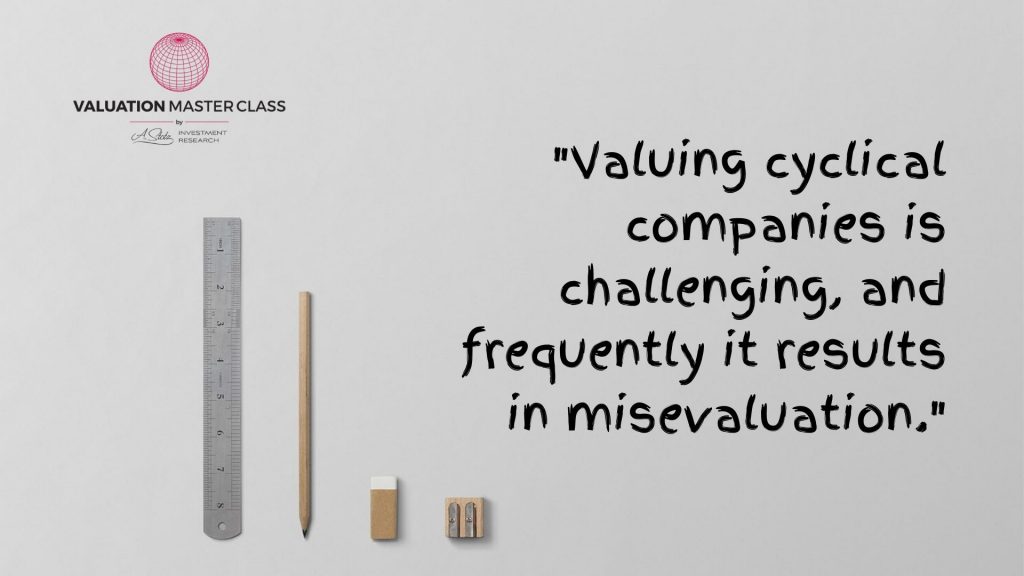How to Value Cyclical Companies
This is a Valuation Master Class student essay by Ratthapark Arnantayakan from November 1, 2017. Ratthapark wrote this essay in Module 2 of the Valuation Master Class.
Cyclical companies have different characteristics compared to non-cyclical companies. One of the main differences is that these companies have volatile earnings due to economic conditions. In terms of valuation, it is necessary to find normalized earnings for valuing cyclical companies. With normalized earnings, cyclical companies are more fairly valued.
What are cyclical companies and how are they different?
Cyclical companies are a group of companies whose performance is sensitive to the business cycle. Thus, when the economy is growing, these companies perform well, and their performance drops significantly during an economic downturn. A good example is car manufacturers; a new car often isn’t deemed necessary when the economy and your income are tight. On the other hand, when the economic situation improves, you might buy one.
The difference between cyclical companies and non-cyclical companies is their level of correlation to economic fluctuations. Cyclical companies are highly correlated with the movement of the business cycle. On the other hand, non-cyclical companies, also called defensive companies, have little to no movement that correlates with the business cycle.
Cyclical companies capture most of the increases in spending as consumers are more willing to spend their additional earnings on these items during economic growth. Conversely, defensive businesses with essential goods such as water, electricity, and gas, have sticky demand as individuals can’t live without these goods and won’t cut back on them even when times are tough.
Factors affect the share price volatility of cyclical companies
Share prices of cyclical companies are discounting news and events immediately, even if the events are not realized until sometime in the future. This is because the main factor that drives the share price of cyclical companies is the expected future cash flows. Thus, the next question is, what factors have an impact on the cash flow expectation? Several factors play a key role in this expectation.
Gross Domestic Product (GDP)
As mentioned earlier, cyclical companies are affected directly by the economy’s overall performance, often measured by the GDP. Thus, these companies are expected to perform well when GDP grows fast and vice versa.
Stock-market Indices
Stocks of cyclical companies generally have a positive correlation with an index such as Dow Jones Industrial Average (DJIA) and S&P500. Thus, when the index rises, cyclical stocks tend to increase as well. However, if the index goes down, the stocks fall. This is probably because investors view the movement of indexes as a gauge of overall economic strength.
Consumer confidence
Consumer Confidence Index (CCI) is often mentioned in the analysis of cyclical companies. This is because it tracks how much people are saving versus how much people are spending in order to know their purchasing power, which has a huge impact on the performance of cyclical companies. An increase in the CCI means people are more willing to spend their money, so cyclical companies should do well, and their stock prices go up. In contrast, people are economizing if CCI decreases leading to poor performance of cyclical companies and a fall in stock prices.
Valuation of cyclical companies and how volatile earnings affect the valuation
Valuing cyclical companies is challenging, and frequently it results in misevaluation. The most common approach to deal with this challenge is called normalized valuation. This methodology allows us to answer a question: How much earnings, reinvestment and cash flow would the company have generated in a normal year?
Three standard techniques are used for normalizing earnings and cash flows: absolute average over time, relative average over time, and sector average.
Absolute average over time
The concept of this approach is to average earnings over a certain period. As suggested by Ben Graham, the Dean of Wall Street, the period used must be at least ten years to ensure that it covers an entire cycle. The advantage of this approach is simplicity, and the disadvantage is that it can somehow lead to underestimation for companies with rapidly growing earnings.
Relative average over time
This method is to average the net profit margin over time, instead of net profit, and apply the average margin to revenues in the most recent period. The result would be normalized earnings. This technique can be applied to capital expenditure and working capital, as well.
Sector average
For companies with limited history and operating changes, it’s more reasonable to use sector average to calculate the normalized earnings. The concept is that we find the average operating margin for all automobile companies over the past ten years and then apply the margin to estimate the operating income of an individual automobile company. The advantage of this approach is that the sector margin tends to be less volatile than an individual firm. However, the disadvantage is that the difference in operating efficiencies of each company in the industry may lead to a significant difference in operating margin.
For cyclical companies, normalized earnings make good sense
By using volatile earnings in valuing cyclical companies can result in either underestimation or overestimation. For example, using the current’s earning, which is at the top of the cycle, can lead to overvaluation. This is because earnings may be puffed up or deflated by economic conditions, not by the firm’s competitive advantage. Thus, using normalized earnings for valuation would be more accurate and reasonable.
Conclusion
When valuing cyclical companies, it’s necessary to take the economic cycle into valuation as it significantly affects the companies’ performance in the long term. However, it is very difficult to forecast where the company will be in the cycle year by year. Thus, using normalized earnings by averaging the past’s earnings or the average margin over a certain period such as ten years, will give more reasonable valuation results so better investment decisions.
References
Wesley R. Gray, Tobias E. Carlisle (2012). Quantitative Value: A Practitioner’s Guide to Automating Intelligent Investment and Eliminating Behavioral Errors.

